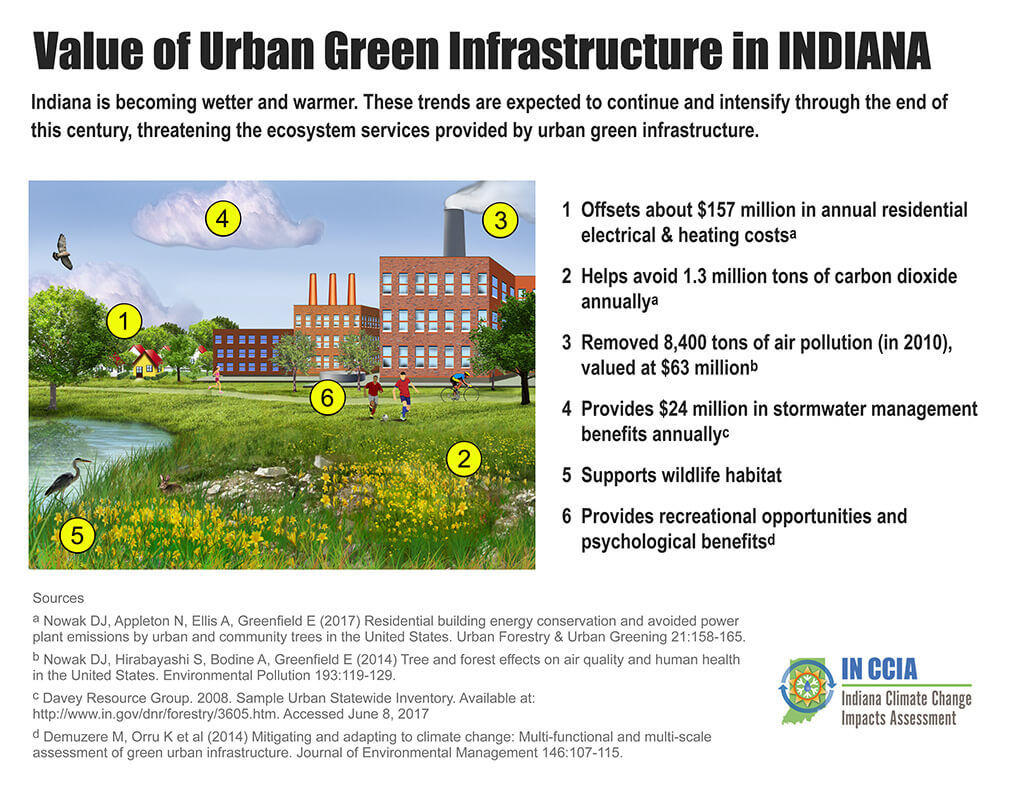Indiana’s forests and urban green infrastructure could look dramatically different over the next century due to warmer temperatures and changed precipitation patterns brought on by climate change, according to the latest two reports by the Purdue University-based Indiana Climate Change Impacts Assessment.
The reports – Indiana’s Future Forests and Maintaining Indiana’s Green Spaces – were released during a community briefing on May 15 at St. Thomas Lutheran Church Heritage Hall in Bloomington.
“We are grateful to our authors and partners, including the many stakeholders who provided input for these reports,” said Jeff Dukes, director of the Purdue Climate Change Research Center. “Our goal is to provide information that will spark new conversations among professionals, decision-makers, and the public.”
Richard Phillips, associate professor of biology at Indiana University and lead author of the forest report, said predicted changes in climate – including warmer, wetter springs followed by hotter, drier summers, might increase the number of tree species growing in the state but could also deter some species currently growing here. He added that changes in the makeup of the state’s forests will depend largely on what action Hoosiers take now to alleviate future climate change.
“The forest products industry in the state of Indiana generates about $7.5 billion annually so you can imagine there’s a lot of concern about changes in species composition that are likely to occur,” Phillips said.
According to the report, habitat suitability is expected to increase for 43 to 52 percent of tree species currently grown in Indiana and decrease for 17 to 29 percent of species currently grown here. In addition, the combination of warmer summer temperatures and drier soils will likely decrease tree growth and timber production. The number of days with frozen soil is projected to drop by half or two-thirds by the late century, which would dramatically shrink the timeframe for harvesting trees without environmental disturbance or damage.
Heather Reynolds, associate professor of biology at Indiana University, said effective planning is vital to help mitigate the worst effects of climate change on the state’s urban greenspaces – including parks, gardens, and wooded areas.
“These greenspaces constitute infrastructure – providing communities with many ecosystem benefits,” she said. “From streetscapes to rooftops, green infrastructure helps to control floods, purify air and water, moderate air temperature, store carbon, control pests, provide fresh foods, and offer recreational, cultural, education and ecotourism opportunities.”
A video recap of the community briefing on the forest and urban greenspaces reports is now available.
The Indiana Climate Change Impacts Assessment (IN CCIA) has compiled the latest scientific research into a series of easily understandable reports about climate change impacts in nine topic areas: climate, water resources, health, energy, forest and urban ecosystems, aquatic ecosystems, tourism and recreation, agriculture and infrastructure. The assessment team consists of more than 100 experts from Purdue and other Indiana institutions.
The IN CCIA has now released four reports. All are available on the IN CCIA website. For more information about the IN CCIA, go to the website or follow on social media at @PurdueCCRC, #ClimateChange, #INCCIA.
Note to Online Editors
A link to a video recap of the IN CCIA community briefing on the release of the forestry and urban greenspaces report is now available and can be embedded on your website.






